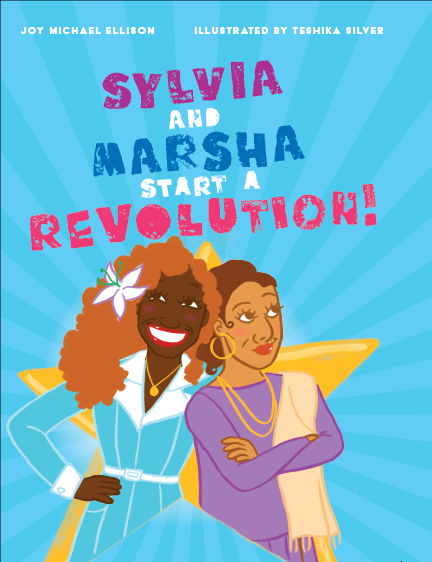
Written by Joy Michael Ellison and colorfully illustrated by Teshika Silver, Sylvia and Marsha Start a Revolution (2021) is a fantastic snapshot of queer activist history.
In the picture book, Marsha and Sylvia are often represented walking down a city street, arms linked, a golden halo surrounding them. Marsha has dark-brown skin and flowing honey-colored hair. Sylvia’s skin is light-brown; her wavy hair is both darker and shorter than Marsha’s. The women are fierce friends who help each other, but also support the queer youth who hangout on New York City’s Christopher Street.
Image and text provide brief insights into what motivates the women’s community involvement. For instance, early in the text, an image of Sylvia as a child provides readers a glimpse into her past. Sylvia is shown wearing a dress over jeans, head down, as if ashamed. An older woman is seen towering over her. The image is explained in the text: “She remembered what her grandma said when Sylvia wore a dress the first time.” Sylvia’s grandmother told her that she was a boy and needed to act like it.
Ellison immediately challenges this, noting that both Sylvia and Marsha are transgender girls.
The experience of vulnerability and pain that Sylvia and Marsha share with each other and with transgender people generally encourages them to imagine a more just future while acting in the present to support the trans community,
Some battles are more easily won than others. For example, in one image, an older cisgender woman is shown pointing at Marsha and proclaiming that she is a man in a dress. Marsha quickly rejoins that she is a woman, and she rejoices in her queer gender expression.
This scene is followed by transphobia that is far more difficult to challenge – that of police violence. An image of a feminine person centers the text. Police, framed in grey, are depicted on one side of the centered image; Marsha and Sylvia, framed in bright green, can be seen on the other. The person at the center yells: “Here comes Alice in the blue dress.” Below the image, text explains that the phrase is a code used to warn others that the police are coming. Readers are informed that police can arrest transgender women for wearing dresses. Although Martha can laugh at an older woman mocking her dress, her and Sylvia are forced to run when confronted with institutionalized transphobia.
Sylvia and Marsha both desired a transformed world where they would be respected, and where their basic human needs would be met. They work together to create that world.
The first focus of their collective action is the Stone Wall Rebellion of 1969.
The two women are shown celebrating Marsha’s birthday at the Inn. Then, it is raided by police who began to arrest patrons. Marsha and Sylvia are depicted helping their friends resist arrest.
The following day they joyfully walk down the street only to experience more police harassment. They lament the constant injustice while watching transgender youth run from the police.
The women decide to help transgender young people by getting a house they can live in safely. The next image is of a cozy living room. Several people sit around talking comfortably. The accompanying text reads: “Young transgender girls came from miles around to live with Sylvia and Marsha.”
The book ends by proclaiming that Marsha and Sylvia “spent their lives fighting for the survival and rights of transgender people.”
Much of the back matter addresses children. Young readers learn about how Marsha and Sylvia met, and that Sylvia was homeless from the age of eleven. There’s also a very accessible glossary of terms about gender.
Other details are provided to contextualize Sylvia and Marsha’s story, including a brief history of the Stonewall Rebellion as well as a description of Street Transvestite Action Revolutionaries (STAR).
Additional back matter is addressed to parents and teachers. This includes discussion questions, further resources, and extension activities. These features add to the teachability of an already strong text that will make a wonderful addition to libraries.
Ellison doesn’t dive into too much detail in the narrative itself, although, as mentioned, back matter provides scaffolding to help readers contextualize the story. It’s accessible enough to read with children as young as six-years-old who will certainly understand the basic message of advocating for self and community. Older readers can use the book as a starting point and then dive deeper into the issues touched on in the text. Overall, this is an essential contribution to the ever-growing field of LGBTQ+ nonfiction picture books. To my knowledge it is the first to focus on transgender women of color in a field that tends to be dominated by the stories of white LGBTQ+ historical figures.
Leave a comment